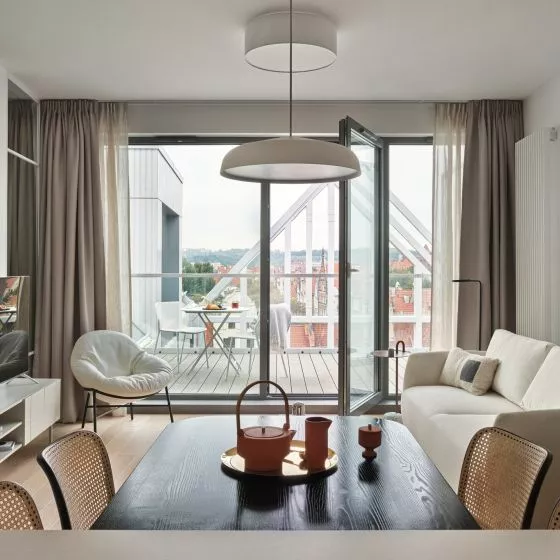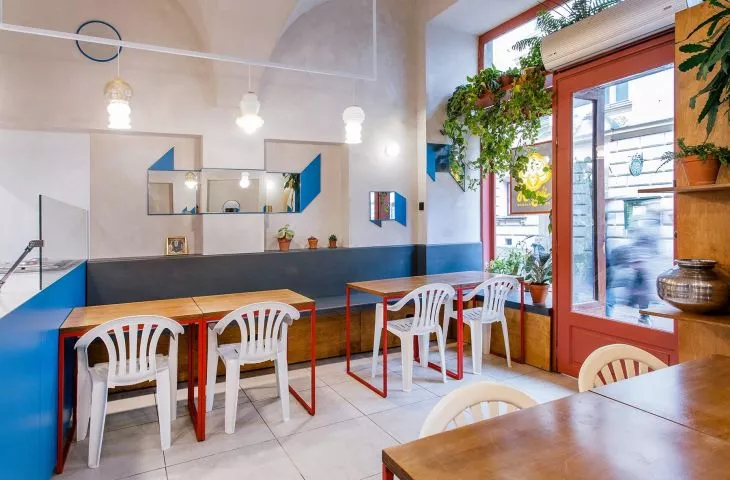A small bistro serving South Indian cuisine has been established in the center of Krakow, on Slawkowska Street. Dominika Wilczynska and Barbara Nawrocka of miastopracka are responsible for the Rangji Masala Dosa design, which combines the symbolism of Hindu myths with the forms and colors of Bauhaus. Welcome to the interior!
Rangji Masala Dosa's project was an interesting exercise in combining form and ideas for the architects from miastopracownia. The result of the work is a marriage of the symbolism of Hindu myths and the language of Bauhaus triadic ballet. The new forms are clearly separated from the historic interior by geometry and color. The added interior elements are mainly blue solids. The partition walls and bar create a composition of blocks, which is continued in the wall collages.
The architects introduced blue blocks into the interior
Photo: Michal Lichtanski, Mili.Studio © miastopracownia
A series of oppositely located mirrors gives the impression of levitating cuboids, or rather molecules taken from legends about Ranji - the Hindu deity, the sleeping Vishnu, lying on the ocean of causes and creating successive universes, the architects explain.
The stark geometry is softened and interwoven with greenery, concentrated in the entrance area of the bistro, providing a second layer of glass display. The designers decided to introduce lighting on a suspended frame. Stacked on top of each other, secondhand lampshades from the People's Republic of Poland are associated with oriental lanterns or costumes from Schlemmer's ballet. Completing the whole arrangement are the seats - white monoblocs. They are a furniture-symbol for the architects, best expressing both Indian and Polish contemporary folklore.
Sharp geometry is interwoven and softened by plants
Photo: Michal Lichtanski, Mili.Studio © miastopracownia
Dobrawa Bies: What were the assumptions and design inspirations? Was it easy to convince investors to use such contrasting colors?
miastopracownia: We would like to greet Pawel, our investor! He is not only an expert in cuisine, but also in South Indian culture, so you could say that we created the narrative for Rangja together from the beginning. We also agreed on recycling issues - hence, for example, the lampshades from the People's Republic of Poland turned into triadic lanterns. He was quickly persuaded by the white chairs - monoblocks and the introduction of vegetation. In terms of aesthetic choices, he actually gave us full freedom. As for colors, let's remember that it is in India that the luscious color festival of Holi is most joyously celebrated, and Krishna himself is blue-skinned. So we don't think the combination of coral red with blue pulled from the vault of St. Mary's is any great extravagance.
The lampshades from the People's Republic of Poland have been turned into triadic lanterns
Photo: Michal Lichtanski, Mili.Studio © miastopracownia
Dobrawa: The premises where the bistro is located have a small area. How do you functionally design such a difficult space?
cityopracownia: The most time needs to be spent on the functional layout, and then we need to design custom furniture. Rangji has a simple floor plan, but the ATM, which is located in the outer wall, had to be accessed from the inside. As a result, it took up half of the already small space in front of the bar. In response, a mobile, screen-like structure was created, with mirrors and space for potted plants so fitted into the bench system that it leaves as much seating as possible.
The series of mirrors gives the impression of levitating cuboids
Photo: Michal Lichtanski, Mili.Studio © miastopracownia
Dobrawa: How does the design of public interiors differ from private ones? Does it allow for more freedom?
miastopracownia: The level of comfort in design is determined by how much freedom the investor will give us. Added to this are such determinants as the scale of the investment, time and budget, and this division does not always run along the lines of private versus public. In both, the reproduction of instagram and pinterest canons is nowadays humbling, and this is something we try to defend against. Maybe that's why we are most often approached by specific investors who prefer experiments instead of established recipes. That's why we haven't yet had a chance to feel that any of these categories are combined with less design freedom :)
Dobrawa: Thank you for the interview!











































